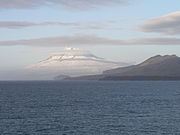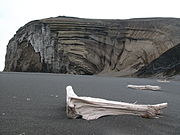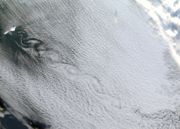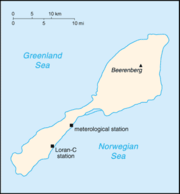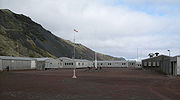
Jan Mayen
Background to the schools Wikipedia
Arranging a Wikipedia selection for schools in the developing world without internet was an initiative by SOS Children. SOS mothers each look after a a family of sponsored children.
 NASA satellite image of Jan Mayen, Beerenberg covered with snow |
|
 |
|
| Geography | |
|---|---|
| Location | Arctic Ocean |
| Coordinates | 70°59′N 8°32′W Coordinates: 70°59′N 8°32′W |
| Area | 373 km² |
| Highest elevation | 2,277 m (7,470 ft) |
| Highest point | Beerenberg |
| Country | |
|
Norway
|
|
| County | Nordland |
| Largest city | Olonkinbyen (pop. ca 18) |
| Demographics | |
| Population | 14–30 |
| Density | under 0.1 |
Jan Mayen Island is a 55 km (34 miles) long (southwest-northeast) and 373 km² (144 mi²) in area arctic volcanic island in the Arctic Ocean, partly covered by glaciers (an area of 114.2 km² around the Beerenberg). It has two parts: larger northeast Nord-Jan and smaller Sør-Jan, linked by an isthmus 2.5 km wide (1.6 mi). It lies 600 km (about 400 mi) north of Iceland, 500 km (about 300 mi) east of central Greenland and 1,000 km (about 600 mi) west of the North Cape, Norway. The island is mountainous, the highest summit being the Beerenberg volcano in the north. The isthmus is the location of the two largest lakes of the island, Sørlaguna (South Lagoon), and Nordlaguna (North Lagoon). A third lake is called Ullerenglaguna (Ullereng Lagoon). Jan Mayen was formed by the Jan Mayen hotspot. It is part of the Kingdom of Norway.
Economy
Jan Mayen Island has no exploitable natural resources. Economic activity is limited to providing services for employees of Norway's radio and meteorological stations located on the island. It has one unpaved airstrip about 1,585 metres (5,200 ft) long, Jan Mayensfield, and the 124.1 km (74.1 mi) of coast include no ports or harbours, only offshore anchorages.
There are important fishing resources outside the island, and the existence of Jan Mayen establishes a large Exclusive Economic Zone around it. A dispute between Norway and Denmark regarding the fishing exclusion zone between Jan Mayen and Greenland was settled in 1988 granting Denmark the greater area of sovereignty.
Jan Mayen is an integral part of Norway, not considered a dependency with special status. Since 1995, it has been administered by the County Governor (fylkesmann) of the northern Norwegian county of Nordland which is closest to it; however, some authority has been delegated to a station commander of the Norwegian Defence Logistics Organisation, a branch of the Norwegian Defence Forces.
Society
The only inhabitants on the island are personnel working for the Royal Norwegian Defence Force or the Norwegian Meteorological Institute. There are eighteen people who spend the winter on the island, but the population may double during the summer, when heavy maintenance is performed. Personnel serve either six months or one year, and are exchanged twice a year in April and October. The main purpose of the military personnel is to operate a LORAN-C base. The support crew, including mechanics, cooks and a nurse, are among the military personnel. Both the LORAN transmitter and the meteorological station are located a few kilometres away from the settlement Olonkinbyen (English: The Olonkin City), where all personnel live.
Transport to the island is provided by C-130 Hercules military transport planes operated by the Royal Norwegian Air Force that land at Jan Mayensfield, which only has a gravel runway. The planes fly in from Bodø Main Air Station eight times a year. Since the airport does not have any instrument landing capabilities, visibility is required, and it is not uncommon for the planes to have to return to Bodø, two hours away, without landing. For heavy goods, freight ships visit during the summer, but there are no harbours and the ships must anchor up.
The island has no indigenous population, but is assigned the ISO 3166-1 alpha-2 country code SJ (together with Svalbard), the Internet country code top-level domain ( ccTLD) .no ( .sj is allocated but not used) and data code JN. Its amateur radio call sign prefix is JX. It has a postal code, N-8099 JAN MAYEN, but delivery time varies, especially during the winter.
|
||||||||||||||
History
Unverified discoveries
The first known discovery of the island was in 1614. There are earlier claims and possible discoveries: Some historians believe that an Irish monk, Brendan, who was known as a good sailor, was close to Jan Mayen in the early 6th century. He came back from one of his voyages and reported that he had been close to a black island, which was on fire, and that there was a terrible noise in the area. He thought that he might have found the entrance to hell.
The land named Svalbarð ("cold coast") by the Vikings in the early medieval Landnámabók may have been Jan Mayen (instead of Spitsbergen, which was renamed Svalbard by the Norwegians in modern times); the distance from Iceland to Svalbarð mentioned in that book is two days sailing, consistent with the ~530 km to Jan Mayen and not with the ~1550 km to Spitsbergen. The knowledge of Jan Mayen probably disappeared along with the Viking colonies on Greenland around the 14th century.
In the 17th century many claims of the island's rediscovery were made, spurred by the rivalry on the Arctic whaling grounds, and the island received many names. According to Thomas Edge, an early 17th century whaling captain who was often inaccurate, William (sic) Hudson discovered the island in 1608 and named it Hudson's Touches (or Tutches). However, Henry Hudson could only have come by on his voyage in 1607 (if he had made an illogical detour) and had made no mention of it in his journal. Edge also suggested that Thomas Marmaduke, a Hull whaling captain, saw the island in 1612 and named it Trinity Island. There is no cartographical or written proof for either of these "discoveries".
1614 discoveries and final naming
Jan Mayen was discovered in the summer of 1614, probably within one month by three separate expeditions. The English whaler John Clarke, sailing for a Dunkirk firm, had observed the island on June 28 while hunting Greenland right whales (now called Bowhead Whales) and named it Isabella. In January the “Northern Company” ( Noordsche Compagnie), modelled on the Dutch East India Company, had been established to support Dutch whaling in the Arctic. Two of its ships, financed by merchants from Amsterdam and Enkhuizen, reached Jan Mayen in July 1614. The captains of these ships ( Jan Jacobsz May of Schellinkhout on the “Gouden Cath” (Golden Cat) and Jacob de Gouwenaar on the “Orangienboom” (Orange Tree), named it Mr. Joris Eylant after the Dutch cartographer Joris Carolus who was on board and mapped the island. The captains acknowledged that a third Dutch ship, the “Cleyn Swaentgen” (Little Swan) captained by Jan Jansz Kerckhoff and financed by Noordsche Compagnie shareholders from Delft, had already been at the island when they arrived. They had assumed that the latter, who named the island Maurits Eylandt (or Mauritius) after Maurice of Nassau, Prince of Orange, would report their discovery to the States General. However, the Delft merchants had decided to keep the discovery secret and returned in 1615 to hunt for their own profit. The ensuing dispute was only settled in 1617, though both companies were allowed to whale at Jan Mayen in the meantime.
In 1615, Robert Fotherby went ashore, apparently thinking it a new discovery and naming the island Sir Thomas Smith’s Island and the volcano “Mount Hakluyt”. Jean Vrolicq, a French Basque whaler who was active in the Spitsbergen fishery at least as early as 1618, renamed the island Île de Richelieu.
Jan Mayen first appeared on Willem Jansz Blaeu’s 1620 edition map of Europe originally published by Cornelis Doedz in 1606. He named it Jan Mayen after captain Jan May of the Amsterdam-financed Gouden Cath, perhaps because he was by that time based in Amsterdam. Blaeu made a first detailed map of the island in his famous “Zeespiegel” atlas of 1623, establishing its current name.
Jan Mayen as a Dutch whaling base
From 1614 to 1638, Jan Mayen was used as a whaling base by the Dutch Noordsche Compagnie, which had effectively monopolized whaling in most of the Arctic Sea over those years. It took ships about three weeks to reach the island from the Netherlands. By 1616, 200 men were seasonally living and working on the island and over 10 Dutch ships hunted in the bays of the island each year. By the 1620s, six whaling stations had been established (spread along the NW coast), with wooden storehouses and dwellings and large brick furnaces, and two fortresses with batteries to protect the stations. Among the sailors active at Jan Mayen was the later admiral Michiel Adriaensz de Ruyter. In 1632, at the age of 26, he was for the first time listed as an officer and his last whaling trip was in 1635.
In 1632 the Noordsche Compagnie expelled the Danish-employed Basque whalers from Spitsbergen. In revenge, the latter sailed to Jan Mayen, where the Dutch had left for the winter, to plunder the Dutch equipment and burn down the settlements and factories. Captain Outger Jacobsz of Grootebroek was asked to stay the next winter (1633/34) on Jan Mayen with six shipmates to defend the island. While a group with the same task survived the winter on Spitsbergen, all seven on Jan Mayen died of scurvy or trichinosis (from eating raw polar bear meat) combined with the harsh conditions.
The Greenland right whale was locally hunted to near extinction around 1640 (approximately 1000 had been killed and processed on the island), at which time Jan Mayen was abandoned and stayed uninhabited for two and a half centuries.
19th and 20th century
During the International Polar Year 1882-83 an Austro-Hungarian expedition stayed one year at Jan Mayen and performed extensive mapping of the area, their maps being used until the 1950s. Between 1900 and 1920, there were also a number of Norwegian trappers spending winters on Jan Mayen, hunting white and blue foxes in addition to some polar bears. But the exploitation soon made the profits decline, and the hunting ended.
The first meteorological station was opened in 1921 by the Norwegian Meteorological Institute, who annexed the island in 1922 for Norway. By law of February 27 1930 the island was made part of the Kingdom of Norway. During World War II Jan Mayen was not occupied by Germans as continental Norway was in 1940, but still the meteorologists chose to burn down the station. In 1941, they returned with soldiers to rebuild the station. On 7 August 1942 a German Focke-Wulf Fw 200 "Condor", probably on a mission to bomb the station, smashed into the mountainside of Danielsenkrateret near it in fog, killing all 9 crewmembers. In 1950, the wreck of another German plane with 4 crewmembers was discovered on the southwest side of the island. In 1943, the Americans established a radio locating station named Atlantic City in the north to try to locate German radio bases in Greenland.
After the war the meteorological station was located at Atlantic City, but moved in 1949 to a new location. Radio Jan Mayen also served as an important radio station for ship traffic in the Arctic Ocean. In 1959, NATO decided to build the LORAN-C network in the Atlantic Ocean, and one of the transmitters had to be on Jan Mayen. By 1961, the new military installations, including a new air field, were operational.
For some time scientists doubted if there could be any activity in the volcano Beerenberg, but in 1970 the volcano erupted, and added another three square kilometres (1.2 sq mi) of land mass to the island during the three to four weeks it lasted. It had more eruptions in 1973 and most recently in 1985. During an eruption the sea temperature around the island may increase from just above freezing to about 30 Celsius degrees (86 °F).
Historic stations and huts on the island are Hoyberg, Vera, Olsbu, Puppebu (cabin), Gamlemetten or Gamlestasjonen (the old weather station), Jan Mayen Radio, Helenehytta, Margarethhytta, and Ulla (a cabin at the foot of the Beerenberg).
Geography
Jan Mayen consists of two geographically distinct parts. Nord-Jan has a round shape and is dominated by the 2277 m high Beerenberg volcano with its large ice cap (114.2 km²), which can be divided into twenty individual outlet glaciers. The largest of those is Sørbreen, with an area of 15.00 km² and a length of 8.7 km.
South-Jan is narrow, comparatively flat and unglaciated. Its highest elevation is Rudolftoppen with 769 meters. The station and living quarters are located on South-Jan.
Geology
The island lies on the world's smallest microplate. The island was previously attached to Greenland

